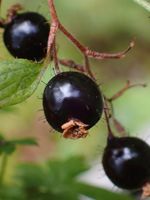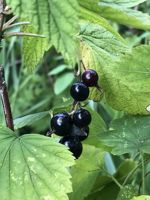Mon-Fri 9am - 5pm Mountain time
Bristly Black Currant vs American Black Currant
Ribes lacustre
Ribes americanum
CUSTOM GROW
CUSTOM GROW
Bristly Black Currant is a native deciduous shrub that grows in moist forests, swamps, and riparian areas. In summer, it produces clusters of dark purple to black berries that provide food for wildlife, while its reddish-purple flowers attract pollinators. The berries are technically edible and enjoyed by some, but many find them unpleasant and bitter.
Thriving in moist soils and shaded locations, Bristly Black Currant helps stabilize soil and supports diverse habitats. It is valuable for conservation plantings, wetland restoration, riparian buffers, and naturalization projects.
Note: When crushed, the berries are known to release an offensive odour.
American Black Currant is a native deciduous shrub known for its clusters of small black berries that ripen in mid-to-late summer. The berries are edible and have long been used for fresh eating, preserves, and baking. They provide food for birds and mammals, and their fragrant spring flowers attract bees and other pollinators.
American Black Currant’s foliage serves as a host plant for butterfly species such as the Green Comma and Gray Comma, and its dense branching offers cover for wildlife. The shrub has traditionally been planted in shelterbelts, riparian buffers, and restoration projects.
Bristly Black Currant Quick Facts
American Black Currant Quick Facts
Toxicity: prickles may cause an allergic reaction

